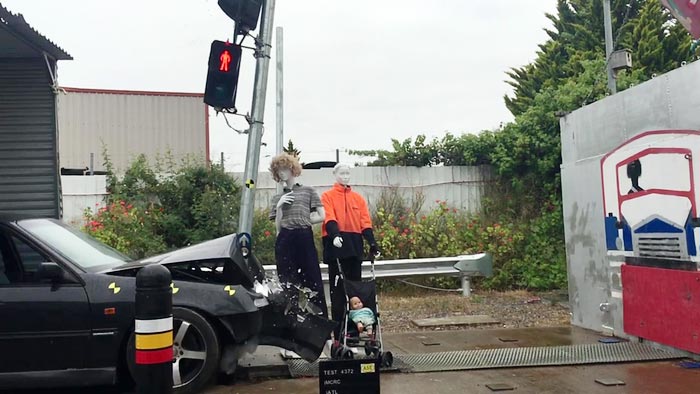World-first product will be a lifesaving traffic stopper

A test with a vehicle shows how the traffic lights absorb the impact of a collision
Credit: University of South Australia
Game-changing technology to design traffic lights that absorb kinetic energy, stopping them from crumpling when hit by a vehicle, will prevent thousands of fatalities and injuries each year and make our roads much safer.
That’s the prediction from University of South Australia (UniSA) senior lecturer and research lead Dr Mohammad Uddin, who is partnering with manufacturing company Impact Absorbing Systems (IAS) on a new project to minimise collision-related injuries as well as damage to traffic lights and vehicles.
The $640,000 project, partially funded by the Innovative Manufacturing CRC (IMCRC), will leverage IAS’s expertise in road safety and UniSA’s engineering design and advanced manufacturing skills to ensure traffic lights absorb a high-impact crash, remain undamaged and operational, and save pedestrian and motorists’ lives.
Dr Uddin says the technology involves replicating existing IAS-fabricated energy absorbing bollards and tuning the design to better suit the shape, length and size of common traffic lights, while satisfying regulatory standards.
“Recent statistics show that in Australia, traffic light collisions cost $18.5 million a year in fatalities, $53.7 million for injuries and up to $16 million annually to repair, install and maintain traffic lights,” Dr Uddin says. Worldwide, the figure is much higher.
“By using the best design and materials which absorb the impact, the traffic lights won’t crumple if hit, but just tilt to a slight angle, stopping an out-of-control vehicle. Existing traffic lights are rigid steel, hollow structures which cause severe and fatal injuries to pedestrians and motorists when a vehicle smashes into them.
“The cost to human life is bad enough, but they also leave councils with a significant bill to repair and replace them.”
Operating out of UniSA’s Testlab and engineering design facilities, the team will use advanced manufacturing techniques, materials testing and computational modelling to build and test various designs, delivering a world-first product that complies with road safety standards.
The researchers will also integrate smart sensors into the final design, which will monitor the state and performance of the traffic lights, helping councils to maintain them.
IAS industry lead Grad Zivkovic says the collaboration with UniSA and IMCRC will “revolutionise” current traffic light design.
“By leveraging UniSA’s R&D expertise, we will develop an effective solution that has the potential to improve road safety worldwide,” Zivkovic says.
“This project will also create pathways for Australian manufacturers to fabricate and supply components of the energy absorbing traffic lights throughout its development and commercialisation, supporting local industry and global export opportunities.”
Dr Uddin says the project should be completed within the next 12 months and the product ready for use by 2023.
“We expect these new energy absorbing traffic lights (EATL) will be the standard model going forward, not only for new installations but also to gradually replace existing lights.”
IMCRC’s Manufacturing Innovation Manager, Dr Matthew Young, says the EATL technology will also benefit local councils and the government by reducing health costs and replacement costs of traffic lights.
“There are significant opportunities all round,” he says.
Media Contact
Candy Gibson
University of South Australia
candy.gibson@unisa.edu.au
Office: 61-434 605 142
All latest news from the category: Transportation and Logistics
This field deals with all spatial and time-related activities involved in bridging the gap between goods and people, including their restructuring. This begins with the supplier and follows each stage of the operational value chain to product delivery and concludes with product disposal and recycling.
innovations-report provides informative reports and articles on such topics as traffic telematics, toll collection, traffic management systems, route planning, high-speed rail (Transrapid), traffic infrastructures, air safety, transport technologies, transport logistics, production logistics and mobility.
Newest articles

Properties of new materials for microchips
… can now be measured well. Reseachers of Delft University of Technology demonstrated measuring performance properties of ultrathin silicon membranes. Making ever smaller and more powerful chips requires new ultrathin…

Floating solar’s potential
… to support sustainable development by addressing climate, water, and energy goals holistically. A new study published this week in Nature Energy raises the potential for floating solar photovoltaics (FPV)…

Skyrmions move at record speeds
… a step towards the computing of the future. An international research team led by scientists from the CNRS1 has discovered that the magnetic nanobubbles2 known as skyrmions can be…





















